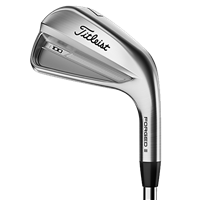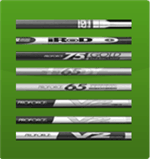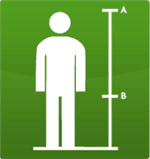Buying advice for Golf Irons
 Shop for Golf Irons
Shop for Golf Irons
Golf irons comprise the majority of clubs in your bag. From tee shots to the approach to the green, they are very much the precision equipment of the game and can be used for a variety of shots on the course.
The best golf irons are generally broken down into two main categories - blades and cavity backed. Blades provide greater feel and flexibility for an experienced player. While cavity backed irons are preferred by those newer to golf, as they are generally easier to hit and provide greater control and distance.
When considering which irons to buy it is important to weigh up all of the options and at GolfOnline we stock a wide range from all the major manufacturers, including Callaway, Mizuno, TaylorMade and Titleist.
Blades or Cavity Backed
Bladed golf irons are usually made from steel and provide greater feel. Meaning if you catch the ball with the sweet spot, you'll know about it. Hitting it out of the middle gives you more distance and the desired trajectory, which you need if you want to find the green and leave yourself with a birdie chance. These are perfect for serious golfers who want to make swing adjustments if they don't 'middle' an approach or tee shot.
The vast majority of golf irons available today are made by casting. A process that is perfect for making cavity backed clubs because it gives manufacturers the chance to be creative. An option that is great for players new to the game is the addition of perimeter weight, meaning the ball will still travel a fair distance, and generally straight, even if it doesn't come off the middle of the face.
Lie Angle
If you're taller or shorter than average or have an unusual swing, you will need to consider the lie angle of your golf irons. As a general rule, shorter players will benefit from flatter lies, while taller golfers may need them tweaked a little more upright to make sure the ball comes off the face straight.
Shaft
When looking for the best golf irons the material the shaft is made of is something you should seriously consider. Steel or graphite? In the simplest of terms the difference is the weight of the irons, with graphite being much lighter. This means the club can be swung quicker through the air, generating more distance.
However, graphite is more expensive than steel and doesn't offer the consistency you get with a metal shaft. After hitting a few balls with a steel-shafted iron you'll know exactly how it behaves and the power you need to play a pin-point shot to the pin.
Many male players think steel shafts make the best golf irons, as their weight is not an issue, whereas junior and female golfers more often choose graphite shafts for their flexibility and quicker swings.
Custom Golf Irons
To ensure the best out of your new set of irons, we recommend getting custom fit to optimise your clubs length, lie angle, grips and shafts. We believe this is crucial and will help to improve your game dramatically. GolfOnline is proud to provide a superior custom fit service. Book in your appointment today and start reaping the on-course rewards.
Expand All

Irons are not about distance; they are about precision and distance
control. Try not to get swayed by manufacturers claims about massive
distance in their irons.
Accuracy is far more important to an iron than distance. Leave thoughts of distance for when you buy a driver.
In fact several iron manufacturers have been known to lower the loft of
their irons and increase the shaft length (which increases distance) and
then suggest the increased distance is due to clubhead improvements
Irons - A Long Term Investment

It is essential that you buy a well designed set of irons. Irons are
mostly about distance control and are specially weighted and have
different shaft lengths so that they can cover a large range of
distances. Irons are probably the hardest wearing clubs in your bag and
you will only need to replace them after a few years (for the
moderately frequent player) when the grooves lose their edge.
You may
therefore consider increasing your budget as you realize how long a
decent set can last. If you buy a decent set now, you will be less
inclined to buy a more expensive set in a year from now.
Cavity Back Irons vs Blades

If you struggle with your irons, go for as forgiving an iron as you can
get. These are called cavity back irons, and they benefit all golfers.
With perimeter weighting the club twists less during impact so more
energy is transferred to the ball.
There are a few other clubs which maximise their use of weighting to
benefit players with a slice. If you tend to slice the ball, look out
for clubs which promote a draw.
You should only consider getting blades or muscle back irons if you are a
low handicap player.
These irons feel great when the ball is struck
from the sweetspot and provide great feedback and workability; however
they are extremely unforgiving and can even be painful when the ball is
struck away from the sweetspot.
If you buy blades, you should try them out first and look at them as a
long term investment. Spend your money wisely as these irons can be
quite pricey.
Forged irons are more expensive due to the manufacturing
process but they are definitely worth it for blades.
The average golfer (mid to high handicap) should look for a large amount
of cavity back and a slightly oversized face.
This will give the
forgiveness required without compromising on feel or distance.
An iron with a small cavity and little offset will allow you to work the
ball from left to right and right to left. This is great if you are
starting to lower your handicap and want the freedom to manipulate the
ball.
Graphite Or Steel Shafts?

As with a driver, you need to choose the right shaft type to get the
most out of your irons in terms of distance and accuracy. Unlike
drivers, you can opt for either steel or graphite shafts with irons.
Graphite offers further distance than steel (due to its lighter weight
and faster swing speeds), which is good, but it can really push up the
price of a set of irons.
How Many Irons Are You Buying?

Check the
price of irons sets carefully, making sure that you don???t just compare
the first price you see. Irons used to be sold in the standard format
of 3 iron to sand wedge.
Due to the introduction of hybrids and separate
wedges, many companies offer options where you do not have to buy the
long irons like the 3 and 4 (and sometimes the sandwedge). Some
packages even come with replacement hybrids in the set.
This is also very convenient if you already have a set of wedges (or
intend to buy them). You can save money here to spend on the wedges and
hybrids that you would probably shell out extra for later on.
Ever Wondered About Custom Fitting?

Everyone's
golf swing is different so it makes sense to adjust golf clubs to suit the
individual.
Custom
fitting is the process for tailoring a golf club to suit your personal swing.
Effectively golf club manufacturer's know that a set of clubs aren't cheap so
the least they could do is make them fit.
Whatever
your level, the aim is to ensure that if you do make a good swing, the club
will be square at impact and should produce a straight shot.
Anything
that can be changed on the club to help you hit the ball more accurately and consistently can be
considered as custom fitting. Custom fitting can include everything from
changing the shafts to the thickness of the grips, from have the lies and lofts
adjusted to having the length of shaft altered. This is becoming a very popular
option for a lot of golfers nowadays, not just the professionals and it is definitely
something to think about when purchasing a new set of irons.